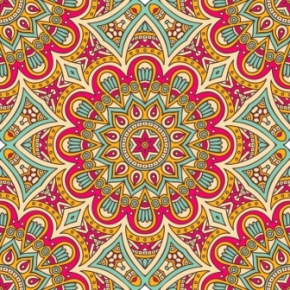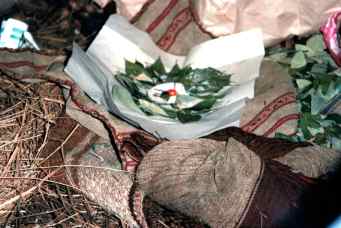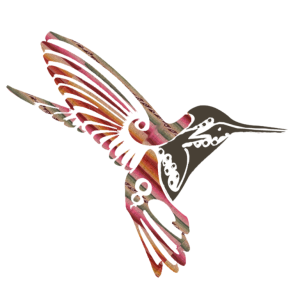The Inka Empire was called the Tawantin Suyo because it united four previously separate regions into a single state. “Tawa” in Quechua means the number four, and “ntin” is a linguistic convention indicating things are joined together. In the mystical vocabulary, a tawantin takes on added meaning, relating to wholeness, harmony, beauty, and fullness.
 A mandal, in the Hindu and Buddhist traditions, is a geometric figure that represents the universe, and in its most basic form it incorporates the number four in its design. The Tibetan word for mandala means “that which contains or encircles the center,” and a basic mandala has a center and four gates. A mandala as a symbolic structure mirrors the deep internal order of nature and the cosmos.
A mandal, in the Hindu and Buddhist traditions, is a geometric figure that represents the universe, and in its most basic form it incorporates the number four in its design. The Tibetan word for mandala means “that which contains or encircles the center,” and a basic mandala has a center and four gates. A mandala as a symbolic structure mirrors the deep internal order of nature and the cosmos.
The Inka concept of tawantin shares similarities, as does graphical depictions of a tawantin. In the Andean mystical system, a tawantin represents the whole, and specifically the relationship of the parts to the whole. As such, paqos often refer to the tawantin as the organizing principle not only of the outside, but of the inside—of the self.
It’s interesting that when Q’ero paqo don Andres Espinosa built and became the “headmaster” of a paqo school tucked away high in the Andes, behind the main building was a huge square courtyard with a smaller building positioned at each of the four corners and a huge flat stone in the center of the courtyard with a depression in the middle where despachos were burned. We don’t know if the design of this paqo school was intentional, but it takes the form of a tawantin “mandala,” mirroring the organizing principle of the cosmos on earth.
The despacho (hayway to use the Quechua term) is always, at its most basic, a tawantin. To my knowledge, the simplest, more core form of a despacho is the karpay despacho, which consists of shell placed in the center of the paper and  topped with a cross, and with four k’intus laid in around it. The shell and cross represent the core yanantin energies of the divine masculine and feminine principles . The four k’inuts represent the four cardinal directions and honor the four suyu apus (Ausangate, Salcantay, Saqsaywaman, and Wanakauri). Even if a despacho gets a lot more elaborate, this tawantin mandala is always the foundation upon which it is based.
topped with a cross, and with four k’intus laid in around it. The shell and cross represent the core yanantin energies of the divine masculine and feminine principles . The four k’inuts represent the four cardinal directions and honor the four suyu apus (Ausangate, Salcantay, Saqsaywaman, and Wanakauri). Even if a despacho gets a lot more elaborate, this tawantin mandala is always the foundation upon which it is based.
The most obvious Andean representation of the tawantin is in the chakana, the Andean cross, which has four arms of three “steps” each around a central circle.  The word “chakana” means bridge. The symbol represents the constellation of the Southern Cross, which the ancient Quechuas and the Inkas believed was the center of the universe. The symbol or parts of it, especially the three-stepped arm of the cross, is ubiquitous in Inka architecture. While the three steps represent many triads in the mystical tradition, such as the three worlds (hanaqpacha, kaypacha, ukhupacha) and the three aspects of the self (yachay, llank’ay, munay), the symbol in its entirety is a tawantin—the union of these three with the cosmos into a whole.
The word “chakana” means bridge. The symbol represents the constellation of the Southern Cross, which the ancient Quechuas and the Inkas believed was the center of the universe. The symbol or parts of it, especially the three-stepped arm of the cross, is ubiquitous in Inka architecture. While the three steps represent many triads in the mystical tradition, such as the three worlds (hanaqpacha, kaypacha, ukhupacha) and the three aspects of the self (yachay, llank’ay, munay), the symbol in its entirety is a tawantin—the union of these three with the cosmos into a whole.
Just as there is order outside the self, there is also order inside the self. According to Juan Nuñez del Prado and his masters , we also are tawantin. While the harmonious organization of the self in Jungian psychology encompasses the  conscious self/ego, the unconscious self/shadow, the united animu and anima/royal couple, and actualized Self, for the Andean masters it incorporates the four main chunpis, or energetic belts. The throat represents yachay/thoughts, the heart munay/feeling, the belly khuyay/passion, and the pelvic area atiy/impulse. When we harmonize these four aspects of ourselves into a whole—into a tawantin— we can best express “who we really are.”
conscious self/ego, the unconscious self/shadow, the united animu and anima/royal couple, and actualized Self, for the Andean masters it incorporates the four main chunpis, or energetic belts. The throat represents yachay/thoughts, the heart munay/feeling, the belly khuyay/passion, and the pelvic area atiy/impulse. When we harmonize these four aspects of ourselves into a whole—into a tawantin— we can best express “who we really are.”
There are also energy practices that are tawantin. They usually involve the yanantin of men and women who work together to move energy in particular ways. One of these tawantin practices has two men and two women in the center, with men and women flowing outward from them, the men behind the men and women behind the women. As they flow energy long these “arms” from the center, this whole human mandala is set in motion, like a giant pinwheel. The flow of this moving energy creates munay.
Another tawantin energy practice involves creating two flows of energy within yourself—a saminchakuy flow of sami down from the cosmos to your Inka Seed and a saiwachakuy flow up from the earth to your Inka Seed. As the two energies meet at this center of the self, taqa occurs—an expansion of the personal bubble  and of the self in four directions—to family, to humanity, to the past, and to the future.
and of the self in four directions—to family, to humanity, to the past, and to the future.
In the wachuy exercise of recapitulating your life and returning to the moment of your birth, or even to your conception, there is an energetic flow that centers on the Inka Seed but that encapsulates your male and female aspects and your itu and paqarina. The itu and paqarina relate to the spirit beings of the place where you were physically born and also represent the male/female aspects of yourself. In this exercise, your male/female aspects (including the yanantin of your biological parents) and itu/paqarina form the tawantin.
As you can see, the concept of the tawantin runs deep within the Andean mystical tradition, creating an Inka mandala that is both physical and energetic, both personal and universal.

Thank you Joan. This is a lovely description of the symbolic interplay, the dance. Blessings. I very much enjoy your blog.
Pia
LikeLike
You’re welcome!
LikeLike
Thank you Joan, i enjoy every topic. your points are spot on and perfection!
LikeLike
Love this post. There is so much depth to the practice, there are always new levels to understand even in things you thought you knew.
LikeLike
James, you got that right! After more than twenty years on this path, I am still learning new aspects of it or deepening my understanding.
LikeLike
Beautiful post!
LikeLike
Thank you Joan! I have been reading your posts and each one contains so much information I sometime read it few times to settle it in my mind. One day perhaps your blog can become a book so we can have all this in one place. I would certainly buy it!
LikeLike